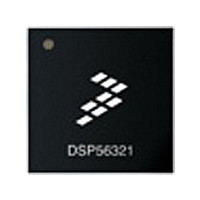DSP56311VF150R2 Freescale Semiconductor, DSP56311VF150R2 Datasheet - Page 10

DSP56311VF150R2
Manufacturer Part Number
DSP56311VF150R2
Description
IC DSP 24BIT 150MHZ 196-BGA
Manufacturer
Freescale Semiconductor
Series
DSP563xxr
Type
Fixed Pointr
Datasheet
1.DSP56311VL150R2.pdf
(96 pages)
Specifications of DSP56311VF150R2
Interface
Host Interface, SSI, SCI
Clock Rate
150MHz
Non-volatile Memory
ROM (576 B)
On-chip Ram
384kB
Voltage - I/o
3.30V
Voltage - Core
1.80V
Operating Temperature
-40°C ~ 100°C
Mounting Type
Surface Mount
Package / Case
196-MAPBGA
Device Core Size
24b
Format
Fixed Point
Clock Freq (max)
150MHz
Mips
150
Device Input Clock Speed
150MHz
Ram Size
384KB
Operating Supply Voltage (typ)
1.8/3.3V
Operating Supply Voltage (min)
1.7/1.7/3/3/3/3/3/3V
Operating Temp Range
-40C to 100C
Operating Temperature Classification
Industrial
Mounting
Surface Mount
Pin Count
196
Package Type
MA-BGA
Lead Free Status / RoHS Status
Contains lead / RoHS non-compliant
Available stocks
Company
Part Number
Manufacturer
Quantity
Price
Company:
Part Number:
DSP56311VF150R2
Manufacturer:
Freescale Semiconductor
Quantity:
10 000
Signals/Connections
1-6
BR
BG
BB
CAS
BCLK
BCLK
Signal
Name
Output
Input
Input/ Output Ignored Input
Output
Output
Output
Type
Reset: Output
(deasserted)
State during Stop/Wait
depends on BRH bit
setting:
• BRH = 0: Output,
deasserted
• BRH = 1: Maintains
last state (that is, if
asserted, remains
asserted)
Ignored Input
Tri-stated
Tri-stated
Tri-stated
State During Reset,
Stop, or Wait
Table 1-8.
DSP56311 Technical Data, Rev. 8
External Bus Control Signals (Continued)
Bus Request—Asserted when the DSP requests bus mastership. BR is deasserted
when the DSP no longer needs the bus. BR may be asserted or deasserted
independently of whether the DSP56311 is a bus master or a bus slave. Bus
“parking” allows BR to be deasserted even though the DSP56311 is the bus master.
(See the description of bus “parking” in the BB signal description.) The bus request
hold (BRH) bit in the BCR allows BR to be asserted under software control even
though the DSP does not need the bus. BR is typically sent to an external bus
arbitrator that controls the priority, parking, and tenure of each master on the same
external bus. BR is affected only by DSP requests for the external bus, never for the
internal bus. During hardware reset, BR is deasserted and the arbitration is reset to
the bus slave state.
Bus Grant—Asserted by an external bus arbitration circuit when the DSP56311
becomes the next bus master. When BG is asserted, the DSP56311 must wait until
BB is deasserted before taking bus mastership. When BG is deasserted, bus
mastership is typically given up at the end of the current bus cycle. This may occur in
the middle of an instruction that requires more than one external bus cycle for
execution.
The default operation of this bit requires a set-up and hold time as specified in
Chapter 2. An alternate mode can be invoked: set the asynchronous bus arbitration
enable (ABE) bit (Bit 13) in the Operating Mode Register. When this bit is set, BG and
BB are synchronized internally. This eliminates the respective set-up and hold time
requirements but adds a required delay between the deassertion of an initial BG input
and the assertion of a subsequent BG input.
Bus Busy—Indicates that the bus is active. Only after BB is deasserted can the
pending bus master become the bus master (and then assert the signal again). The
bus master may keep BB asserted after ceasing bus activity regardless of whether
BR is asserted or deasserted. Called “bus parking,” this allows the current bus master
to reuse the bus without rearbitration until another device requires the bus. BB is
deasserted by an “active pull-up” method (that is, BB is driven high and then released
and held high by an external pull-up resistor).
The default operation of this signal requires a set-up and hold time as specified in
Chapter 2. An alternative mode can be invoked by setting the ABE bit (Bit 13) in the
Operating Mode Register. When this bit is set, BG and BB are synchronized
internally. See BG for additional information.
Note: BB requires an external pull-up resistor.
Column Address Strobe—When the DSP is the bus master, CAS is an active-low
output used by DRAM to strobe the column address. Otherwise, if the Bus
Mastership Enable (BME) bit in the DRAM control register is cleared, the signal is tri-
stated.
Note: DRAM access is not supported above 100 MHz.
Bus Clock
When the DSP is the bus master, BCLK is active when the ATE bit in the Operating
Mode Register is set. When BCLK is active and synchronized to CLKOUT by the
internal PLL, BCLK precedes CLKOUT by one-fourth of a clock cycle.
Note: At operating frequencies above 100 MHz, this signal produces a low-amplitude
waveform that is not usable externally by other devices.
Bus Clock Not
When the DSP is the bus master, BCLK is the inverse of the BCLK signal. Otherwise,
the signal is tri-stated.
Note: At operating frequencies above 100 MHz, this signal produces a low-amplitude
waveform that is not usable externally by other devices.
Signal Description
Freescale Semiconductor











